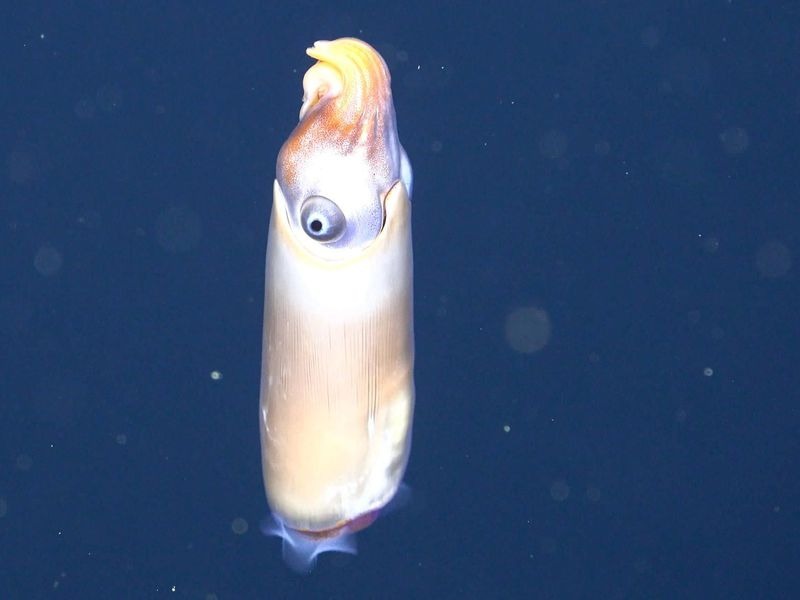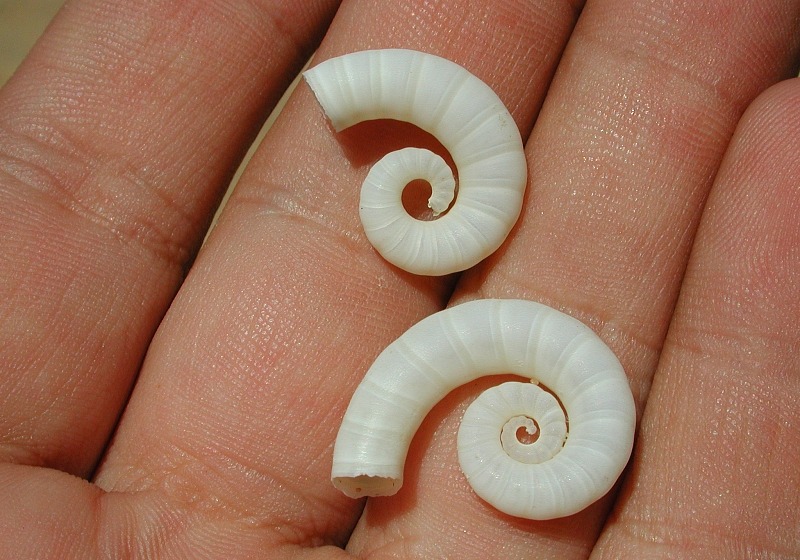mollwollfumble said:
PermeateFree said:
PermeateFree said:

A still from the first ever video of a live ram’s head squid in the wild. (Schmidt Ocean Institute)
Last week, a remotely operated vehicle (ROV) surveying the depths off the northern Great Barrier Reef encountered a mysterious cylinder hanging vertically in the dark water around 2,790 feet. “It looks like a pale eggplant,” remarked one of the ocean enthusiasts who had tuned in to watch a live video feed of the dive.
While that may not sound like a flattering first impression, that pale eggplant turned out to be an elusive species of squid that had never before been caught on camera in the wild, reports Nicoletta Lanese for Live Science.
The cephalopod in question is called a ram’s horn squid (Spirula spirula), the only living member of a unique family of squid.
Both researchers echoed the fact that they’d never seen footage of the small, roughly two-inch squid in the wild. Inside the squid’s oblong mantle lies a multi-chambered spiral shell that looks something like a miniature nautilus shell. That shell is part of what makes the ram’s horn squid special.
They’re the only living species of cephalopod with a coiled internal shell, which regulates the animal’s buoyancy with bubbles of gas, reports Sabrina Imbler for the New York Times. Though their owners have been anything but a common sight for undersea explorers, these whorled shells are commonly found by beachcombers around the world, according to ScienceAlert.
Like many marine creatures that inhabit a world almost completely devoid of sunlight, the ram’s horn can make its own light—the squid sports a bright green photophore on its rear, per the Times.

https://www.smithsonianmag.com/smart-news/strange-squid-filmed-wild-first-time-180976192/

(Oops, try again, I got too excited there)
Oh!
This one! The un-missing link between cuttlefish and nautalus.
Relative of the ammonites perhaps.
Does Spirula spirula have fossils dating way back?
If one accepts Pohlsepia34 as the earliest stem group octopod, this group would have originated in the Carboniferous. Doubt is cast on this hypothesis14 by Pohlsepia’s poor preservation, the ten arms in Jeletzkya douglassae (coeval with Pohlsepia), and the absence of octopod fossils from at least the Permian and Triassic. According to molecular clock analyses by Tanner et al.20, they did not originate before the Triassic, while Kröger et al.1 proposed an Early Jurassic origin. Recently, the first evidence of early stem octopods was presented from the late Kimmeridgian49,50.
Coleoidea (squids and octopuses) comprise all crown group cephalopods except the Nautilida. Coleoids are characterized by internal shell (endocochleate), ink sac and arm hooks, while nautilids lack an ink sac, arm hooks, suckers, and have an external conch (ectocochleate). Differentiating between straight conical conchs (orthocones) of Palaeozoic Coleoidea and other ectocochleates is only possible when rostrum (shell covering the chambered phragmocone) and body chamber are preserved. Here, we provide information on how this internalization might have evolved. We re-examined one of the oldest coleoids, Gordoniconus beargulchensis from the Early Carboniferous of the Bear Gulch Fossil-Lagerstätte (Montana) by synchrotron, various lights and Reflectance Transformation Imaging (RTI). This revealed previously unappreciated anatomical details, on which we base evolutionary scenarios of how the internalization and other evolutionary steps in early coleoid evolution proceeded. We suggest that conch internalization happened rather suddenly including early growth stages while the ink sac evolved slightly later.
Some cephalopod remains from the Early Devonian were interpreted as coleoids based on the similarity of their body chambers to those of two species of much younger phragmoteuthids (Triassic) and based on the presence of a rostrum in another species1. In spite of similarities to the few unambiguous Carboniferous coleoids, some authors have questioned the coleoid nature of these Devonian forms2,3,4,5,6,7. While the absence of coleoid fossils from the Middle and Late Devonian casts doubt on the coleoid nature of these Early Devonian remains, orthoconic cephalopod conchs are poorly studied and thus, early coleoids may have been frequently overlooked or misinterpreted as bactritoids8. Several unequivocal coleoid fossils are known from the Carboniferous and some are even exceptionally well-preserved, thereby providing a great amount of anatomical information5,7,9,10,11,12,13,14,15,16. Most studies on molecular clock data place the divergence of the major coleoid clades (and thus the origin of the crown group) in the Permian or Triassic7,17,18,19,20,21. However, taking the large confidence intervals in these studies into account, even a younger or older divergence date is conceivable and the timing of the origin of coleoids has presently not been accurately resolved by molecular studies.
https://www.nature.com/articles/s42003-019-0523-2


